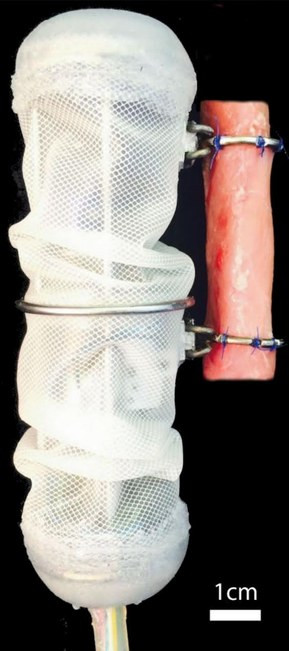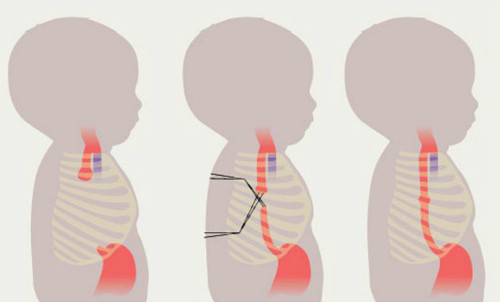Transplant the robot into the infant's body to cure it
Innovative American equipment promotes cell growth and heals injuries when "released" into young children.
Nearly a century ago, Pierre Dupont, a biomedical engineer at Children's Hospital Boston (USA), wondered whether humans could make robots that live and work inside the body. Now, with a breakthrough work, he knows the answer is "yes".

Robot equipment is attached to a piece of pig esophagus.(Photo: Damian et al).
According to Futurism, in Science Robotics, the group of authors from Children's Hospital Boston said they tried attaching a robot device to the pig esophagus and found that after a while, this part of the animal was 77% longer while it still living, eating normally and without any discomfort. In particular, Mr. Dupont said that pig esophagus is not merely stretched but really long thanks to growth cells. Thus, implantable robots can give hope to patients with esophageal atrophy.
Affects one out of 4,000 newborns, esophageal evidence, causing part of the esophagus to be lost. Therefore, it is difficult for babies to suck, choke and vomit, even die if not treated promptly.
For mild cases, the doctor may surgically stitch the two ends of the esophagus together. For these cases, the medical team must use Foker technology to sew the broken ends of the esophagus into two back knots. After a few weeks, these two buttons are tighter to slowly stretch the esophagus. Gradually, the broken esophagus will be connected.

Technical description of Foker.(Photo: SlidePlayer).
Although highly effective, the Foker technique has many disadvantages. During treatment, the child must be given anesthesia and mechanical ventilation to ensure no movement. The hospital stay can be up to three months and the cost falls to about one million dollars.
If successfully applied on humans, implant robots will overcome all problems of Foker technology. In addition, the authors say they will not stop at esophageal atrophy but will continue testing the device on animals with short bowel syndrome.
- Robot performed the first kidney transplant in England
- Use robots to study the behavior of intelligent communication of newborns
- 'Brain transplant' for sex robot to have feelings like real people
- The first transplant patient will become familiar with the new body with virtual reality
- Robot made from 3D printing technology
- Paper robot decomposed in the human body
- Feeding human heart outside the body
- Detects traces of life after the body dies
- Man-robot manufacturing, big step opens up the future?
- Surprised to see the human heart still beating outside the body while waiting for a transplant
- Doctors find new ways to preserve and transplant heart
- Where is the only person who escapes from the HIV death virus?
 Green tea cleans teeth better than mouthwash?
Green tea cleans teeth better than mouthwash? Death kiss: This is why you should not let anyone kiss your baby's lips
Death kiss: This is why you should not let anyone kiss your baby's lips What is salmonellosis?
What is salmonellosis? Caution should be exercised when using aloe vera through eating and drinking
Caution should be exercised when using aloe vera through eating and drinking